Artificial Intelligence in Agriculture. Part 2: How Farming is Going Automated with AI Technologies
AI • May 06,2016
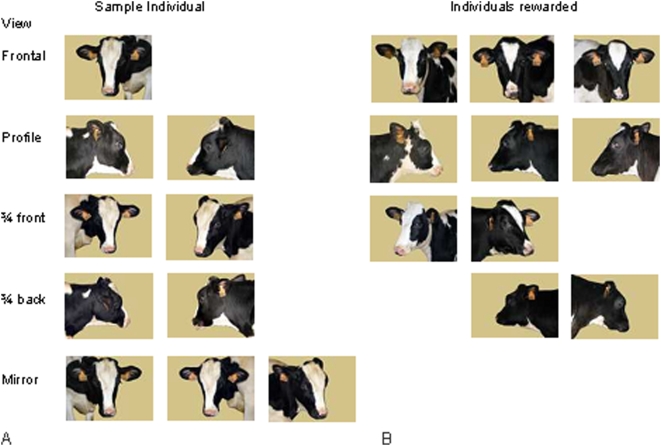
Artificial Intelligence in Agriculture. Part 2: How Farming is Going Automated with AI Technologies
As you may read from our first article farming robots are shaping agriculture and will feed humans of the future. Economics will demand a leap from theoretical concept of artificial intelligence to its practical application in agriculture, many experts suggest. But this process has already begun and is irreversible. Automated irrigation systems, crop health monitoring, face recognition systems for domestic cattle, CBR systems for fishing industry and many others are clear examples of how AI can be the Holy Grail for the farming industry.
Automated irrigation systems

Irrigation systems are as old as man itself since agriculture is the foremost occupation of civilized humanity. To irrigate large areas of plants is an onerous job. In order to overcome this problem many irrigation scheduling techniques have been developed which are mainly based on monitoring the soil, crop and weather conditions.
Irrigation scheduling engrosses when to irrigate and how much water to be applied. There are 4 types of automated irrigation systems:
● Closed loop system which is based on a predefined irrigation scheme the control system takes over and makes detailed decisions on when and how much water to apply
● Open loop system which is based on the amount of water to be applied and the timing of the irrigation
● Volume based system which is based on a pre-set amount of water that can be applied in the field
● Time based system which works with time clock controllers
Automated irrigation systems can reduce production costs of vegetables, making industry more competitive and sustainable, increase average vegetable yields, minimize environmental impacts caused by excess applied water and subsequent agrichemical leaching, maintain desired soil water range in the root zone that is optimal for plant growth, create low labor input for irrigation process maintenance and save water compared to irrigation management based on average historical weather conditions.
Potato sorting system
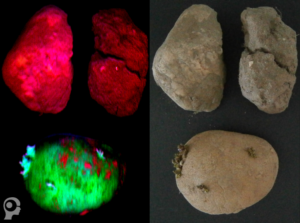 Four years ago researchers at the University of Lincoln’s Robotics Lab built an artificial intelligence robotic system that sorts and can detect potato diseases such as silver scurf and common scab. The test system uses computer kit not dissimilar from systems many gamers will have in their homes. TADD or the Trainable Anomaly Detection and Diagnosis system is able to detect, identify and quantify many of the common blemishes affecting potatoes. Potato sorting system can demonstrate higher precision of detection of affected or unhealthy potatoes instead of manual selection in industrial scale. Also it can lower labor input and create a possibility for higher food safety assurance.
Four years ago researchers at the University of Lincoln’s Robotics Lab built an artificial intelligence robotic system that sorts and can detect potato diseases such as silver scurf and common scab. The test system uses computer kit not dissimilar from systems many gamers will have in their homes. TADD or the Trainable Anomaly Detection and Diagnosis system is able to detect, identify and quantify many of the common blemishes affecting potatoes. Potato sorting system can demonstrate higher precision of detection of affected or unhealthy potatoes instead of manual selection in industrial scale. Also it can lower labor input and create a possibility for higher food safety assurance.
Crop health monitoring
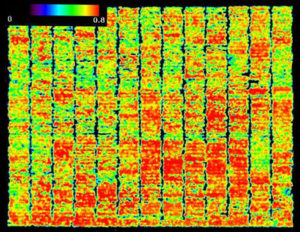
Remote sensing techniques can play quite an important role in land cover survey and as a source of information relating to land resource condition. Crop health monitoring is a great example of agriscience, where hyperspectral imaging and 3D laser scanning is providing enhanced information and plant metrics across thousands of acres with the spatial resolution to delineate individual plots and/or plants and the temporal advantage of tracking changes throughout the growing cycle.
Conventional methods are often time consuming and generally categorical in contrast to what can be analyzed through automated digital detection and analysis technologies categorized as remote sensing tools. The trained use of hyperspectral imaging, spectroscopy and 3D mapping allows for the substantial increase in the number of scalable physical observables in the field which means the multi sensor collection approach creates a virtual world of phenotype data in which all the crop observables become mathematical values.
Face recognition system for domestic cattle
 In order to maintain cohesion of groups, social animals need to process social information efficiently. Visual individual recognition, which is distinguished from mere visual discrimination, has been studied in only few mammalian species. French researchers tested whether 8 Prim’Holstein heifers could recognize 2D-images of heads of one cow from those of other cows.
In order to maintain cohesion of groups, social animals need to process social information efficiently. Visual individual recognition, which is distinguished from mere visual discrimination, has been studied in only few mammalian species. French researchers tested whether 8 Prim’Holstein heifers could recognize 2D-images of heads of one cow from those of other cows.
Facial recognition of cows in dairy units can individually monitor all aspects of behavior
in a group, as well as body condition score and feeding. When it comes to lameness, measuring the arch in the cow’s’ back could give an early sign of the problem. Effect of usage of this system will allow to feed cows a lot less expensively if you know what they will and will not eat. Also it’s possible to fix a lame cow before she shows you signs of lameness, which can save months of lower milk production.
Autonomous early warning system for oriental fruit fly
Developing an autonomous early warning system for detecting pest resurgence was an essential task to reduce the probabilities of massive oriental fruit fly outbreaks. By preventing pest outbreaks, farmers would be able to reduce their dependence on chemical pesticides. This autonomous early warning system, built upon the basis of wireless sensor networks and GSM networks effectively captures long-term and up-to-the-minute natural environmental fluctuations in fruit farms. In addition, two machine learning techniques, self-organizing maps and support vector machines are incorporated to perform adaptive learning and automatically issue a warning message to farmers and government officials via GSM networks.
The proposed early warning system can be easily adopted in different fruit farms
without extra efforts from farmers and government officials since it is built based
on machine learning techniques, and the warning messages are delivered to their
mobile phones as text messages.
The Enorasis wireless sensors network
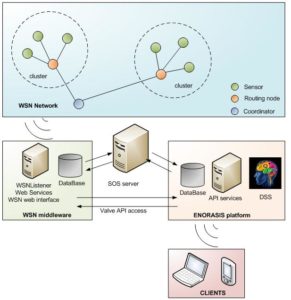
Agriculture industry is experiencing real need of improving the environmental performance of irrigation systems and preventing the misuse of water. That’s why European Union funded researchers have developed a smart irrigation system that calculates the exact amount of water crops need each day. The Enorasis project uses a network of sensors in the fields to determine how much water to give their crops through subsurface drip and micro-irrigation systems. The sensors collect environmental and soil conditions such as soil humidity, temperature, sunshine, wind speed, rainfall and the water valves to quantify water already added to the fields.
Enorasis combines weather forecast and sensor data about the farm’s crops to create a detailed daily irrigation plan that best suits the needs of each crop. The model also includes crop yield data and energy and water costs, helping farmers decide whether extra irrigation will increase yields profitably or cause a loss.
Veepro: information center for dairy cattle
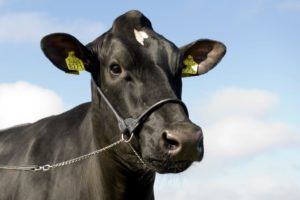 Dutch organisation Veepro created an artificial intelligence expert system which is able to prescribe feed rations, medications, health and welfare conditions for livestock. It can recommend the mating partners for improving genetic potential of offspring. The expert system is able to perform complex analysis of health, reproduction status of individual or groups of animals, to keep track of production and recommend operational measures to be taken in order to improve the farm performance.
Dutch organisation Veepro created an artificial intelligence expert system which is able to prescribe feed rations, medications, health and welfare conditions for livestock. It can recommend the mating partners for improving genetic potential of offspring. The expert system is able to perform complex analysis of health, reproduction status of individual or groups of animals, to keep track of production and recommend operational measures to be taken in order to improve the farm performance.
Veepro gives information about dairy cattle improvement and health care, supports dairy husbandry, dairy cattle improvement and health care. The system can develop and implement fine-tuned breeding programs. The most important selection criteria are milk production, fat and protein percentage, age durability, functional traits (udder, feet and legs), fertility, health, calving ease, and type. The indexes for calculating the breeding
values are constantly updated according to the newest scientific insights.
Decision support system for greenhouse tomato production
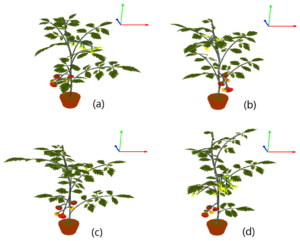
The purpose of greenhouse crop systems is to generate a high quality product at high
production rates, consistently, economically, efficiently and in a sustainable way. To
achieve this level of productivity, accurate monitoring and control of some processes of
the entire biophysical system must be implemented. That’s why decision support system for greenhouse tomato production with artificial intelligence techniques was created. This system uses a set of artificial Intelligence based techniques, such as artificial neural networks, genetic algorithms and grey system theory.
System allows to predict the environmental conditions that influence growth and productivity of tomato plants including day and night air temperature, fruit temperature, radiation, CO2 concentration, fruit load, plant density, stress etc. Also DSS technology makes possible to adjust the fluctuation of temperature affecting mostly the time of fruit ripening and rate of fruit growth.
Use of AI based methods can offer a promising approach to yield prediction and compared favorably with traditional methods.
Early season plant-by-plant phenotypic measurement system
The maize root system is crucial for plant establishment as well as water and nutrient uptake. There is substantial genetic and phenotypic variation for root architecture, which gives opportunity for selection. Zea delivers high-throughput, low-hassle, high-quality plot characterization metrics, with a stand count error rate of less than 5% for plants between V2 and V5 (approx. 5-20” tall). ZEA phenotypic measurement can do unbiased, consistent measurements of stand count, plant spacing, height, greenness and leaf area, across all of locations, at multiple time points and replace field crews and all the hidden costs that come with personnel.
Greenhouse climate controller with AI-based techniques
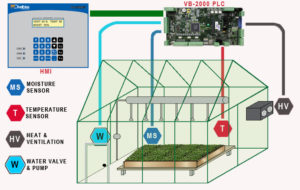
To get the best plant growing conditions temperature and humidity (moisture in the air) have to be controlled. The greenhouse therefore has temperature and humidity sensors linked to a computer, and the computer has a control program storing details of the correct temperature and humidity settings. Researchers created artificial intelligence system and intelligent control methodologies for the analysis and synthesis of intelligent climate controllers. The system uses artificial neural networks (ANNs) and fuzzy logic controllers (FLCs) for the regulation of climate variables like temperature and humidity in artificially conditioned greenhouses.
This controller represents a first attempt to apply an artificial intelligence technique within a greenhouse. Due to the physical dynamics involved within a greenhouse the synthesis of a climate controller becomes a complicated task using traditional control techniques. Fuzzy logic represents a useful tool for solving this problem. From experiments carried out, FLC gives the best performance in terms of precision, energy and also robustness.
Work is still in progress in order to implement a biological model of the plants growth
depending on environment parameters so that it will be possible to automatically
establish the best control policy and to compute the optimal values for the set-points.
GIGAS: Guelph intelligent greenhouse automation system
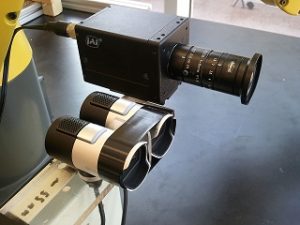
Another example of greenhouse automation system is GIGAS. Greenhouse operations are known to be labour intensive. The objective of this research is to develop an intelligent robotics technology that has significant functional capabilities relevant to a wide range of greenhouse operators. The main challenges are accuracy, cycle time, and cost.
GIGAS components include a vision system with multiple cameras to take images of the plants. At the back end is a plant database that keeps track of all the plants in the greenhouse, with a decision support and planning element, where all the calculations are made. Once a decision is made, that message is sent to the robot that goes and does the job. This robot can gently pick an individual beefsteak tomato, or properly select a tomato cluster for supper. The robot also has a different arm adapted for trimming foliage and de-leafing. Also with this system it is possible to obtain maximum quality yield with best timing of harvest and other operations.
Computational intelligence and geo-informatics in viticulture
Geo-informatics combines geodetic and spatial information processing methods with computing hardware and software technologies. This system includes modelling the effects of the environment, such as climate, atmosphere, soil type, terrain, minerals, transition metals and irrigation of saline water on the development of rootstock, to crop growth and berry ripening rates, protein conversion in different varieties and their composition, within and among vineyards.
The combination of experimental methods using conventional and contemporary computational techniques, together with a range of field dependent software and hardware components brings valuable data for obtaining quality yield of grapes and
high value wines.
Gas fermentation system
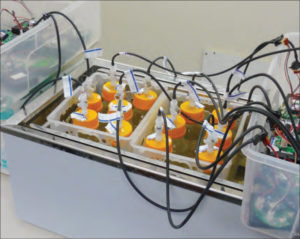
Gas fermentation system is a system that uses artificial intelligence to predict the outcome of fermentation process in cattle. It can provide a level of nutritional analysis of a feed in four hours similar to that achieved in 48 hours by conventional methods. It provides a diagnostic approach to providing qualitative and quantitative data on the rate and extent of carbohydrate digestion by cattle, allows to predict the outcome of fermentation and isolate the effects of additives in during the fermentation process.
Glaucus: CBR system for fishing industry

Glaucus is a case-based reasoning (CBR) system which aims to help fish farmers with
their decision making during sorting operations at their aquaculture sites. System also provides data required for proper fish disease diagnosis and treatment. Glaucus is built in Java and uses the jColibri development framework for CBR. It retrieves cases based on similarity function from myCBR and jColibri in addition to custom made ones.
Glaucus recognizes current situation from the case base and uses the outcome/result of that situation to output a risk with the current situation. The case base is composed of real-world situations which were captured from raw data in an industrial database.
Author: AI.Business
If you like our articles, please subscribe to our monthly newsletter:
[mc4wp_form id=”763″]